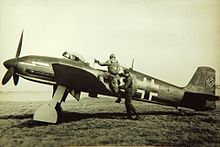Heinkel He 100
| Heinkel He 100 | |
|---|---|

|
|
| Type: | Fighter plane |
| Design country: | |
| Manufacturer: | |
| First flight: |
January 22, 1938 |
| Production time: |
1938-1940 |
| Number of pieces: |
24 |
The Heinkel He 100 was a German fighter aircraft .
history
After Ernst Heinkel with his Heinkel He 112 was defeated by the German Air Force's 1935 competition for the new standard fighter aircraft of the German Air Force against the Messerschmitt Bf 109 , he commissioned his designers Walter and Siegfried Günter with the development of a new fighter aircraft whose target speed was above Should be 700 km / h.
This aircraft initially had the designation P.1035 and was later renamed the He 100.
The first flight of the He 100 V1 took place on January 22, 1938. The machine was equipped with a DB-601 engine from Daimler-Benz and a new type of surface evaporative cooler.
The evaporated cooling liquid was passed through the entire wing surface in order to condense there. This new technology saved the need for an aerodynamically inefficient radiator opening - at least in theory, because the cooling was insufficient for the large V12 engine, for example when starting. For this reason, the designers provided the machine with a radiator that can be extended from the underside of the fuselage. During the cruise it could be completely drawn in. The eighth prototype - the He 100 V8 - reached an average speed of 746.61 km / h on March 30, 1939 with a more powerful engine, started from the Heinkel-Werke Oranienburg airfield , which was the world speed record at the time. The record aircraft was donated to the Deutsches Museum , but for propaganda reasons under the name He 112 U. In further test samples it was found that the surface cooling for more powerful engines, as they were soon used in the Bf 109, was inadequate and could not be expanded . The He 100 represented a dead end in the development of piston-engine-driven fighter planes with their surface cooling.
Since the Bf 109 was already being mass-produced, there were no longer any DB-601 engines available for series production of the He 100, although the Heinkel machine was clearly superior to the Bf 109 in many parameters at the time . For export purposes, the RLM ordered 25 pilot series aircraft (W.-Nr. 3001–3025), which were designated as He 100 D , from Heinkel . After the beginning of the war it was decided that only the W.-Nr. 3001–3016 should be completed. The W. No. 3017–3019 were only produced in the form of spare parts, the rest of the series was canceled. The last He 100 D was delivered in June 1940. In 1940, of the total of 21 aircraft built, two He 100s were sold to Japan and ten to the USSR. The remaining machines were painted black and used for air defense at the Heinkelwerke.
Some of the remaining aircraft of the pre-series He 100 A-0 were used for propaganda purposes, where they were referred to as "He 113".
The aerodynamically very favorable surface cooling, however, always faced the problem of this cooling's sensitivity to bombardment. It was rightly feared that even single hits in the wing could lead to the loss of engine cooling. A return flight behind their own lines or even across the canal therefore seemed difficult to imagine. This was one of the main reasons why the RLM ultimately rejected the He 100 despite its excellent top speed values. Another reason was the capacity utilization of the Heinkel works with bomber production.
Technical specifications
| Parameter | Data He 100 D |
|---|---|
| Wingspan | 9.40 m |
| length | 8.20 m |
| Altitude in flight attitude | 3.60 m |
| Wing area | 14.60 m² |
| Empty mass | 1810 kg |
| Preparation mass | 2010 kg |
| Takeoff mass | 2500 kg |
| Engine | 1 × twelve-cylinder V-engine Daimler-Benz DB 601 M |
| propeller | Three-blade propeller |
| Top speed | 670 km / h |
| Summit height | 11,000 m |
| Range | 1000 km |
| Armament | 1 × 20 mm MG FF cannon |
| crew | 1 man |
See also
literature
- Volker Koos: Ernst Heinkel Flugzeugwerke 1933–1945. Heel Verlag, Königswinter 2003


